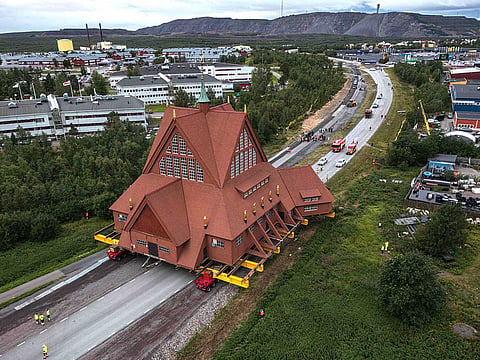Video: Historic Kiruna Church in Sweden arrives at new home after two-day journey
Move has generated widespread interest, with large crowds thronging the streets

A landmark Swedish church in the Arctic arrived Wednesday at its new home after a two-day move across the town of Kiruna to allow Europe's biggest underground mine to expand.
The red wooden Kiruna Kyrka, which dates from 1912 and weighs 672 tonnes, completed its five-kilometre (three-miles) journey around 2:30 pm (1230 GMT).
A musical fanfare celebrated its arrival after a complex, meticulously choreographed relocation that began on Tuesday on two remote-controlled flatbed trailers inching forward at a pace of half a kilometre an hour.
Kiruna's entire town centre is being relocated because of the giant LKAB iron ore mine, whose ever deeper burrowing over the years has weakened the ground.
A stone's throw from where the structure was inching into place next to the town's cemetery, Lutheran vicar Lena Tjarnberg held a church service for dignitaries in a tent resembling a "laavu", the traditional tent of the region's Indigenous Sami people.
"Our beloved, beloved church began its journey yesterday from its unbelievably beloved location. Now it is on its way home," she said.
The journey went smoothly for the 1,200-tonne convoy, despite some tricky narrow passages and 90 degree turns, officials said.
"Everything has gone so incredibly well," project manager Roy Griph told Swedish television SVT, which broadcast the entire move live.
The relocation has generated widespread interest, with large crowds thronging the streets of the town of 18,000 people.
King Carl XVI Gustaf took part in Wednesday's festivities, exchanging a few words with driver Sebastian Druker of Argentina who controlled the trailers remotely with a joystick.
The 79-year-old king was also expected to take part in an attempt to break the world record for the number of people attending a "kyrkkaffe", a church coffee break.
The town's relocation process began almost two decades ago and is expected to continue for years to come. The new town centre was inaugurated in September 2022.
Criticism
The company offered to financially compensate those affected by the town's relocation, or rebuild their homes or buildings. A total of 23 historic buildings, including the church, were moved.
Yet many Kiruna residents are unhappy.
Alex Johansson and Magnus Fredriksson, who host a podcast on local Kiruna news, were critical of the mining company.
"LKAB maybe didn't read the room so well when they destroyed the whole town and then they stage this huge street party for the people," Fredriksson told television broadcaster SVT, watching as the church rolled slowly down the road.
"It's like they said 'Here's some storage space for you, Kiruna. Now we're going to continue raking in the billions from here'," Johansson added.
They were happy the church had at least been saved.
"It's good that it didn't end up as woodchips like the rest of Kiruna," Fredriksson said.
Iron ore, rare earths
LKAB, which is extracting iron ore at a depth of 1,365 metres, announced in 2023 that it had discovered Europe's largest known deposit of rare earth elements right next to the Kiruna mine.
Rare earths are essential for the green transition, used in the manufacturing of electric vehicles.
LKAB chief executive Jan Mostrom told AFP the deposit was "very important for Europe", as the continent seeks to reduce its dependence on imports from China.
"We are quite focused to see how we will continue to expand our operations in Kiruna," he said.
Activists argue the mining operations destroy the area's pristine forests and lakes and disturb traditional Sami reindeer herding in the area.
The relocation of the church alone was expected to cost LKAB some 500 million kronor ($52 million).
Designed by Swedish architect Gustaf Wickman, the church, which measures 40 metres (131 feet) tall, is a mix of influences and includes designs inspired by the region's Indigenous Sami people on the pews.
The neo-Gothic exterior features slanting roofs and windows on each side, while its dark interior has elements of national romanticism as well as an Art Nouveau altarpiece and an organ with more than 2,000 pipes.
The church's handblown glass windows were removed ahead of the move, replaced with painted plywood.
The belltower, which stood separately next to the church, will be moved next week.
Sign up for the Daily Briefing
Get the latest news and updates straight to your inbox



